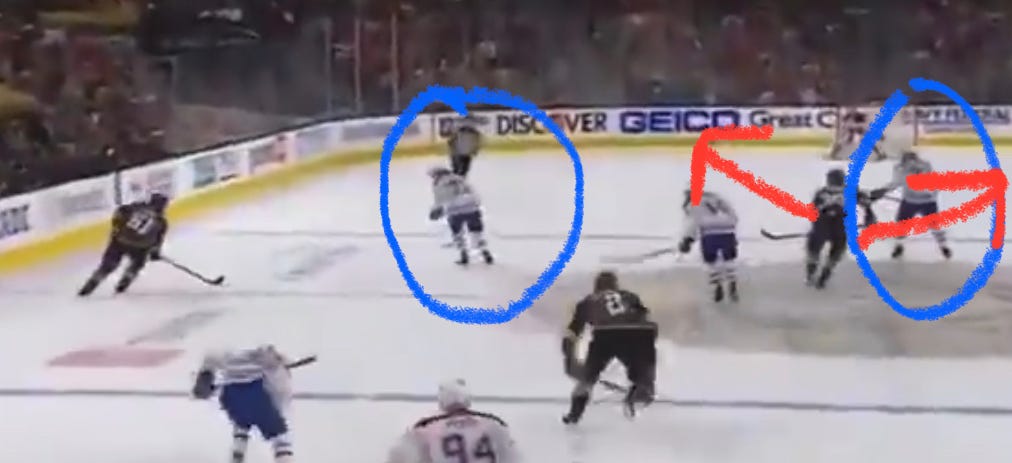In a pivotal Game 5, Vegas Golden Knights superstar Mark Stone turned over a puck in the neutral zone. Seconds later, the Montreal Canadiens scored.
While a lot of blame was rightfully put onto Stone’s plate (#61 black), I think there is an interesting off-the-puck element we should look further at - Chandler Stephenson’s movement (#20 black).
Key players:
Mark Stone #61 Black
Chandler Stephenson #20 Black
Corey Perry #94 White
Cole Caufield #22 White
Awareness
Looking at this sequence we want to notice the puck carrier’s awareness. It’s a critical element to playing great hockey.
Stone failed to look around while carrying the puck. Perry, on the other hand, successfully looked over his shoulder, even while carrying the puck.
You can see his head turning as he scans and picks up two valuable pieces of information:
Pressure is closing quickly
Caufield is with him in support
Perry correctly surmises that his position is inferior to his teammate’s position. He holds onto the puck for another moment to hold the goalie and draw in the opposition before sliding the puck over to Caufield for the goal.
Starting Up Ice
Rewinding the sequence, we can see that a 2v2 situation starts to unfold with a little bit of defensive back pressure behind that.
Starting up the ice, Stone has a few viable options
Carry the puck up the ice
Pass short into the middle to Stephenson
Ice the puck
Given that NHL players ice the puck strategically and not indiscriminately, we can rule that option out.
Meanwhile, Stephenson has three viable options:
Skate wide to look for open space for a passing lane cross-ice. Once over the red line this could turn into a hard-rimmed puck or crash the net.
Skate near behind the strong-side defender (SSD) to look for chip/ bank pass off the boards
Go for a line change
Clearly, they both have energy to give to the cause and the decision is made to sprint up ice.
Neutral Zone
As they cross the red line, we see that Stephenson decided to stay middle/wide. While not the end of the world, he hasn’t done anything to make Stone’s play any easier. By failing to sprint near or truly wide, he has effectively been cut off as an immediate option and leaves Stone in a 1v1 or 1v2 situation. Given 1v1 plays are successful less than 10% of the time, Stone isn’t a good place to be.
Another element is that Stephenson is still ahead of Stone and will be impeded by the blue-line. Rather than making his life easier, Stone now has to also worry about Stephenson going offside.
As Stone skates up the ice, he can see that down the wall will lead him to be cut off easily. Instead, Stone decides to play off his defender’s heels and get to the middle of the ice. Stephenson’s indecision to go near or wide creates problems. He needs to attack between the defensemen or continue to roll his speed into the zone (Shown with red arrows).
Stone eventually skates into the back pressure from #14 white and turns the puck over.
Another example
Funny enough, in the following series MTL #41 (Paul Byron) did the same mistake that leads to a tough play for his teammate and ultimately a turnover.
If #41 in the clip below goes wider (to his left), there is a much bigger passing lane to get the puck. If #41 goes near/behind the SSD, there is open space and should have a good chance at a 2v1 with #44 joining the play with speed.
Exploring Options
Stephenson needs to make a decision early that’ll make Stone’s read simple and easy. Stephenson has always been known for his speed but has failed to truly utilize it here. Stone is a star in the NHL, a team captain, and known for his IQ. He should understand the situation better and best utilize Stephenson’s speed.
Stephenson had two options:
Near - Get ahead of the play and puck to play a 2v1 against the SSD. An area pass into the space behind the defender would’ve been a great way for Stone to lead Stephenson into clear ice. Whitecloud jumping into the play late likely would’ve created a 2v1.
Wide - Roll his speed across the ice to get even or slightly behind Stone. This opens up a passing lane in the NZ and once into the offensive zone, he can attack.
Another great option would’ve been a NZ delay that would’ve used Stephenson as a decoy/ false gap creator. Stone would have hit the breaks and found the next layer in Whitecloud (#2 black) with a positive speed differential and in a great attacking position.
Further Reading:
We explored this type of movement in “Puck Acquisition.” We look at finding better ways to receive the puck and become a dangerous option.
Another look at movement away from the puck is “Genius Level Movement From Erling Haaland”
Did you enjoy this newsletter?
Help us spread the ideas within and share it with the people you care about








